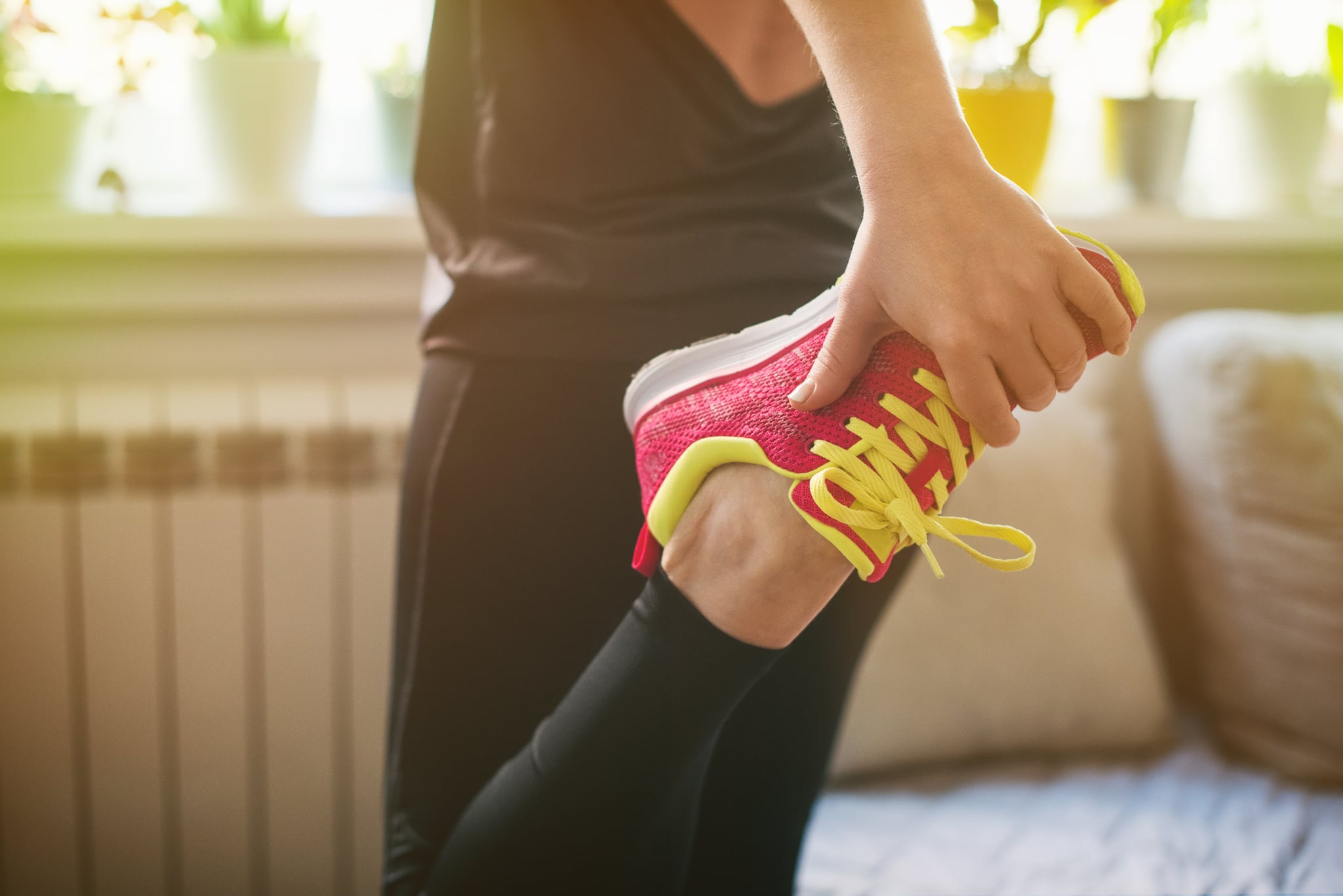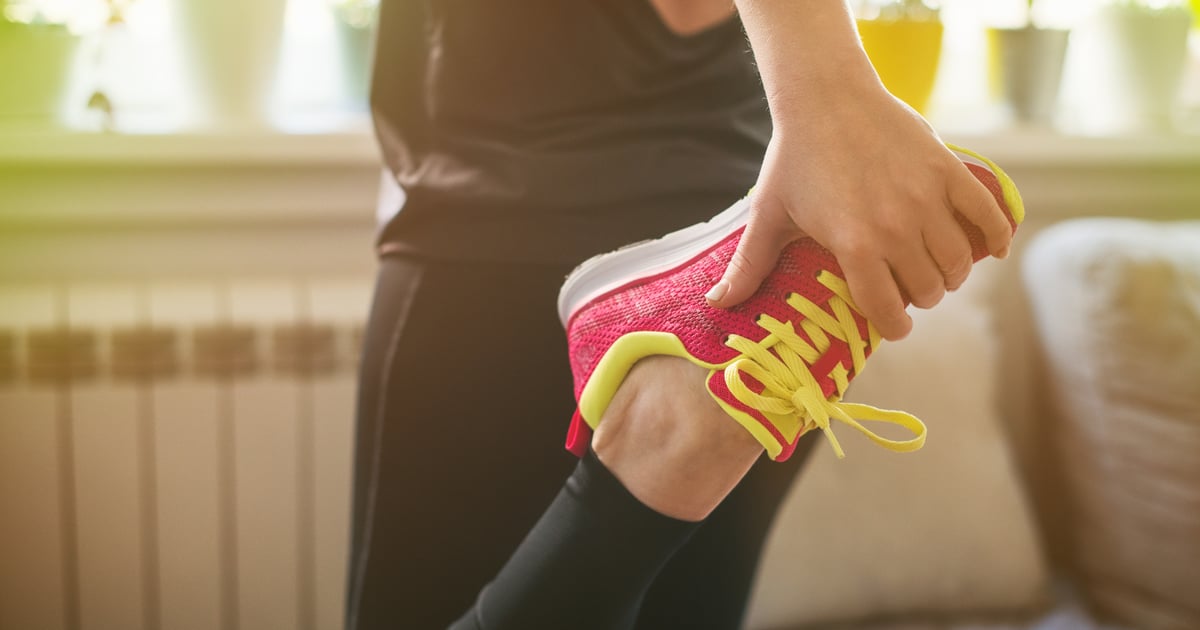
We get it: you’re on your fitness A game, making gains and taking names, when suddenly you’re diagnosed with COVID-19. Rest and recovery should be your top priority, but if you’re feeling OK, you may find that you’re just anxious for the day you can get back to moving. Is it safe to work out if you have COVID-19? And how soon can you get back to your normal exercise routine? Ahead, medical experts explain how to ease back in.
Can I Work Out While I Have COVID?
If you’ve tested positive for COVID, but you have mild symptoms or are asymptomatic, you may be tempted to work out. While you absolutely should not exercise in public while you’re contagious, Chicago-based internal medicine physician, Vivek Cherian, MD, recommends holding off on exercise for seven to 10 days. You want to give your body a chance to fully fight off the infection, and exercising while having an active infection could actually make things worse. If you have compromised lung function such as shortness of breath or congestion, then you should absolutely refrain from working out until you feel better. And once you do, follow the precautions outlined below.
How Soon Can You Work Out After Having COVID-19?
The answer will largely depend on your symptoms, so make sure you discuss your plans with a doctor before diving back in. “Most providers are recommending that you wait at least a week after your symptoms have markedly improved before resuming exercise — but it can be closer to two to three weeks for those who have experienced more significant symptoms that can make just walking up the stairs difficult,” Cassandra Pierre, MD, MPH, MSc, the medical director of public health programs at Boston Medical Center, told POPSUGAR. “These people need a longer period of rest.”
The Centers For Disease Control and Prevention recommends that those who have tested positive for COVID-19 remain in isolation for 10 days, even if they never experience symptoms. You should approach exercise with the same level of caution. “Even if you are asymptomatic — or only had mild illness — and plan to work out at home until you’re officially cleared from isolation, you should at least wait the full 10 days before exercising again,” Dr. Pierre said. “This is because a subset of those with COVID-19 experience clinical deterioration between five and eight days after infection — you don’t want to resume exercise during this period and risk dismissing concerning COVID-related symptoms to the aftereffects of increasing your activity level.”
If you’ve had a severe case of COVID-19 — especially if you developed pneumonia or suffered cardiac symptoms — you should get clearance from your doctor before you begin an exercise regimen. “They will likely have you start out very slowly and work up slowly as well,” explained Sujana S. Chandrasekhar, MD, FACS, a partner at ENT and Allergy Associates, LLP, and a cohost of She’s on Call. “They may have you start with the supervision of a trained physical therapist, who can spot signs of trouble before you yourself may be able to.”
Whatever your circumstances, it’s important that you be patient with your body. “Remember that this virus has an insidious course in a lot of people — even after the infection is gone,” Dr. Chandrasekhar told POPSUGAR. “Listen to your own body and don’t push beyond a reasonable level. Even elite athletes have found that it takes them a longer time to get back up to their usual exercise level. If you push too hard, you may regret it.”
How to Safely Return to Working Out
Again, your doctor can help you assess how to safely ease back into your routine. “Whether you decide to start a low-impact or high-intensity workout after recovering from COVID will be up to your previous fitness capacity and your current level of symptoms,” explained Michael Richardson, MD, a family provider at One Medical in Boston. “If you had relatively mild symptoms, you likely can return to your old workout routine within a week or two. If you had more moderate to severe symptoms, it would be a good idea to dial back the activity and try a less strenuous routine to see how well you can handle exerting yourself. No matter what level of intensity your symptoms were, it’s important to listen to your body and not overexert yourself if you feel unwell.”
Even if you feel like you could hit the ground running, Dr. Chandrasekhar recommended starting at a lower level of exertion than you normally would, perhaps even working out for a shorter period of time. For cardio, think walking instead of running, cycling instead of intense sprints. “Get your lungs, heart, and muscles back into the groove of working out. Then increase your walking speed, then jog, then run,” she said. “Likewise, increase your cycling speed, then resistance, then do some hills. Get to the sprints when your body is ready.”
When lifting, start with much lighter weights than you used before you had COVID-19 — maybe even by half, Dr. Chandrasekhar said. “Lower weights with the same number of reps will restore your tone. When you are ready, increase the weights,” she told POPSUGAR. “Do not do free weights of any consequence — like a free bench press — without a spotter. This is an important time to remember safety protocols.”
As you build back up, “give yourself time to rest, and stay well-hydrated,” Dr. Chandrasekhar said. Expect that you may feel more tired, and make sure you’re listening to those cues. “Don’t be nervous if you’ve done maybe three or four days in a row and just feel tired the next day — make that your day of rest and start up again,” Dr. Chandrasekhar explained. Then, monitor how you feel. “If you don’t feel better after that day of rest, please call your doctor and make sure you haven’t uncovered any significant health problem,” she said.
Dr. Richardson agreed, adding that you should pay attention to your breathing, too. “If you are becoming increasingly short of breath, with or without exercise, it will be important to speak with your primary care doctor to reassess your health and make sure you are recovering appropriately.”
In fact, if you had significant respiratory symptoms while battling COVID-19, you may consider monitoring your blood oxygen saturation levels, using a pulse oximeter. “Checking oxygen saturation with an at-home monitor while gently ramping up exercise can be clinically useful, and signal the need for further evaluation and treatment of low oxygen levels,” Dr. Pierre told POPSUGAR. “There may also be more broad appeal for oxygen saturation monitors for anyone who has had COVID-19 and is concerned — especially for long-haulers who are experiencing long-term shortness of breath — because they may indeed be feeling miserable after resuming exercise after convalescing, and having the monitors can be a great reassurance mechanism.”
The bottom line? “Start slowly, push yourself in a logical and controlled manner, stop if it’s too much, check your pulse ox, and see your doctor if you can’t recover or get back to your ideal level of activity,” Dr. Chandrasekhar said. Those steps should become as second nature as wearing a mask and washing your hands.
POPSUGAR aims to give you the most accurate and up-to-date information about the coronavirus, but details and recommendations about this pandemic may have changed since publication. For the latest information on COVID-19, please check out resources from the WHO, the CDC, and local public health departments.
